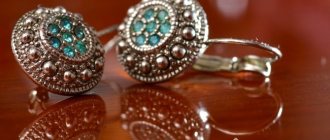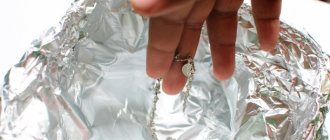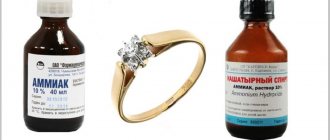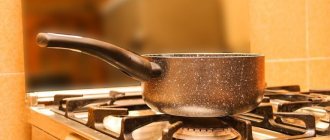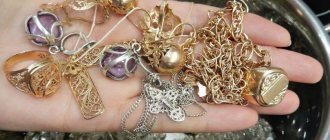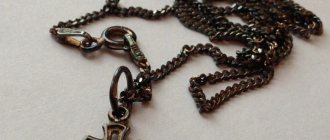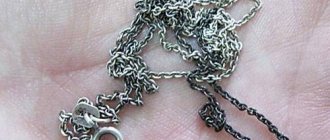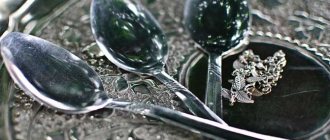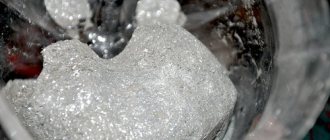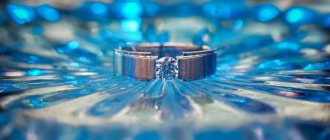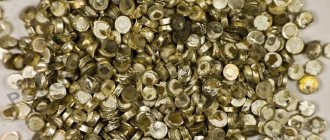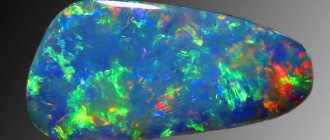February 25, 2021 How to clean silver at home is perhaps one of the most common questions asked by owners of precious metal jewelry. The cool matte sheen and recognizable surface texture seduce many people, but beauty has a downside - silver items darken and oxidize over time, regardless of the intensity of wear. Hence the strict care rules that any buyer must adhere to.
In one of our previous materials, we discussed in detail why silver turns black and what needs to be done about it. Now let’s try to figure out how to effectively clean silver at home so that your chain, cross, rings, bracelet, silver earrings and other jewelry regain their original shine, preserving it for as long as possible.
Preparing for cleaning
To clean silver at home, you need to accurately determine the composition and sample of the metal, choose the right product and processing method.
Getting started with cleaning:
- Inspect the decoration and assess the degree of contamination.
- Choose a cleaning method based on the type of product.
- Prepare everything you need for cleaning: a container with warm water, detergent, napkins, cotton pads and swabs, dry flannel or velvet.
- Soak the items in warm soapy water for 10–20 minutes. for preliminary removal of dust, softening dirt, degreasing the surface.
If there is heavy soiling, especially on jewelry with stones, consider taking it to a jewelry store. Professionals using special means will be able to remove damage, restore an attractive appearance and restore the protective coating of the metal.
How to make a product shine
If you have thoroughly cleaned your silver jewelry from plaque and dirt, but it is still dull and does not shine, then you need to polish it.
The simplest method is to use a special napkin. It consists of a rough and dry cloth that gently polishes the silver, making it smooth and more shiny. This polishing cloth can be purchased at any jewelry store. Its cost, as a rule, ranges from 50 to 300 rubles.
Using a silver polishing cloth is the easiest way to make your silver jewelry shine.
Branded jewelry stores like Pandora often provide a branded polishing cloth with your purchase. Its daily use allows you to avoid darkening of silver and maintain its shine.
A simple waffle towel works great for polishing silverware. After cleaning spoons and forks, use the toughest one you have. Wipe the items with force. This will not only rid the cutlery of the whitish residue that may remain after washing, but will also give them additional shine.
A simple waffle towel will add shine to your silverware.
To restore shine to silver jewelry, use toothpaste (any kind will do). It won't clean silver like tooth powder, but it's great for polishing. Use a soft brush to work the item without scratching it.
Using toothpaste is an affordable and easy way to make your silver shine
Cleaning silver with special means
Professional products are used in jewelry workshops to care for silver items of any kind. Special gels, pastes, sprays, shampoos and wipes quickly and safely remove tarnish, restore shine, and create a protective film on the metal.
You can clean silver with these products at home. You need to use them to wipe off dirt yourself, carefully, strictly following the instructions, observing the dosage and exposure time.
Let's look at the most popular compositions that can be purchased in jewelry workshops.
Talisman
An effective product for cleaning silver jewelry:
- Place the products in a small container.
- Pour in the product so that it completely covers the items.
- After 1-2 minutes, rinse the silver in running water.
- Dry and polish with velvet.
If there are a lot of items, the solution can be reused.
The liquid is not suitable for cleaning blackened silver, as well as items with natural or artificial stones and gold plated.
Talisman can be ordered in the online store. Cost per package of 150 ml from 150 to 250 rubles. depending on the seller.
HG cream
Professional product for cleaning and adding shine to dishes, cutlery, and decorative elements. The cream effectively removes plaque, brightens blackened areas, polishes the surface without damaging the metal. Suitable for antique blackened silver items.
To clean dishes or decorations:
- Wash items in warm water and soap.
- Apply a little cream to a napkin and treat the surface.
- After 1–2 min. Polish the silver until it shines.
The price for a 125 ml package of cream is 500–550 rubles.
Silberpflege Centralin
A gentle paste for cleaning all precious and non-precious metals. Safe for sterling silver, blackened items, rhodium-plated or gold-plated jewelry. The product effectively removes plaque, brightens the metal, and creates a protective film against oxidation on the surface.
To clean silverware or jewelry:
- Apply a little paste to the sponge.
- Spread evenly over the surface. Leave for 2-3 minutes.
- Rinse under running water.
- Wipe dry.
A tube with a volume of 75 ml can be purchased for 250 rubles. in any online store.
When choosing a professional silver care product, consider the grade, type of metal and the presence of stones in the jewelry.
Silver cleaning products
Why silverware darkens: 4 reasons
Reason No. 1 - silver alloy
Any silverware, trays, dishes, etc. will darken over time (the exception is rhodium silver). Therefore, cleaning can only maintain the appearance of silver, but it cannot be completely corrected. The standard 925 alloy is approximately 92.5% pure silver and 7.5% other metals, including copper. These two substances (silver and copper) interact with sulfur compounds in the air and, as a result, oxidize. In fact, it looks like a dark coating.
IMPORTANT: The degree and intensity of darkening of silver devices depends on the percentage of copper in the alloy - the more copper, the faster the product becomes covered with a dark coating.
The spoon on the left (darkest) has the highest copper content in the alloy, the spoon on the right has medium copper content, and the spoon in the middle has the lowest copper content (lightest).
Silverware in three different alloys and compositions
Reason No. 2 - improper storage
- Silver does not tolerate moisture . Moisture accelerates darkening. Therefore, you should not put silverware in a cabinet near the oven, hood, dishwasher, etc.
- The proximity to plastic and rubber also does not suit silver. Therefore, you should not store it in plastic containers. A decorative box made of wood, lined with flannel, is ideal. A simpler option is foil or parchment. They will prevent silver from oxidizing.
Store each silver item separately from each other. Silver is a soft metal, so it scratches quickly. Throwing all the silverware in one box is a bad idea, wrapping each piece of silverware separately in foil/flannel/parchment and placing it side by side is a good idea.
TIP : Place an activated carbon tablet in the place where silver objects are located. It absorbs water well, thereby maintaining an optimal level of humidity.
An example of proper silverware storage
Reason No. 3 - improper washing
- Silverware should not be washed in the dishwasher. Otherwise, a coating will form on the dishes.
- Silverware should be washed and dried immediately after use. You cannot leave silverware in the evening after guests and wash it in the morning.
Leftover food will oxidize and leave dark spots.
- After you have washed your silverware, you must wipe it dry. And only then put it in the case.
Silverware with stains from the dishwasher
Reason No. 4 - sulfur-containing products
Silver oxidizes and darkens from sulfur-containing products: eggs, onions, fish, milk, mayonnaise. As for silverware, contact cannot be avoided. But it is better not to use a silver tray for herring under a fur coat.
Tarnished silver teaspoons
Cleaning jewelry with stones
Turquoise
Pomegranate
Pearl
Emerald
Coral
Moon rock
Malachite
Ruby
Sapphire
Topaz
Amber
Jasper
Jewelry inlaid with precious or semi-precious stones requires careful selection of cleaning methods depending on their type:
- Aquamarine, emerald, sapphire are dense stones that are not afraid of high temperatures and active processing. To remove plaque, wipe the metal with alcohol and polish with soda.
- Turquoise, moonstone, malachite - have an average area; do not tolerate prolonged contact with water, rough friction and hot water. Soapy water, soda slurry or diluted alcohol are suitable for cleaning.
- Amber, mother-of-pearl, and pearls should not be washed with aggressive agents, boiled, or cleaned with brushes. To lighten silver, go over the surface with a school eraser and wipe the stone with a damp cloth. Aggressive compounds can cause pearls to turn yellow.
When starting to clean, find out what kind of stone is set in the ring or earrings. If accurate information is not available, wash your jewelry with warm water and soap or contact your jeweler.
How to clean silver with stones
How to clean blackened silver
Products made from blackened silver are distinguished by an abundance of decorative elements: recesses, grooves, and ornaments.
Such items require regular care to remove dust, dirt, and plaque.
To properly wash blackened silver at home:
- Pour 1 glass of warm water into a deep cup, add 2 tbsp. l. liquid soap.
- Add a pinch of salt.
- Mix thoroughly until the ingredients are completely dissolved.
- Immerse the silver in the solution and leave for 30 minutes.
- Gently clean the metal with a soft cloth.
If you need to freshen dishes, candlesticks, rings or any other items with a smooth surface, use a quick cleaning method using a school eraser. Spot-process the metal until it shines, being careful not to touch the blackened areas. Then, rinse with warm water and wipe dry with a soft cloth.
Old blackened silver heirlooms are more resistant to cleaning and polishing than new jewelry. Modern production technology involves chemically applying a thin film, creating the effect of darkening individual areas. With active exposure, the coating quickly wears off and white spots appear.
To clean blackened silver items, do not use acids, alkalis, abrasives, boiling water, or alcohol compounds.
How to clean rhodium plated silver
Silver earrings or rings coated with rhodium, when properly cared for, are not subject to corrosion; they retain their appearance longer and do not darken. To clean them at home, do not use ammonia-containing, alkaline or acidic products.
The most effective and safest method:
- Prepare a soap solution from any foaming composition (liquid soap, dish soap, shampoo).
- If significant contamination is noticeable in the relief, fasteners, or hard-to-reach places, leave the silver in the composition for 10–15 minutes. Rinse under running water.
- Dry with a soft microfiber or flannel cloth.
- To make silver shine, apply a few drops of glycerin to a cotton swab and treat the metal. Polish with velvet.
Soap and glycerin degrease the surface well, remove plaque and dirt, and restore shine. In addition, the method is safe for products with stones.
Rules for caring for silver products
To ensure that silver jewelry always delights you with its brilliance and beauty, you need to follow simple rules for its use.
- It is better to store silver items in a separate closed box, and preferably so that they do not come into contact with each other. For this purpose, there are special cases for jewelry with soft compartments.
- It is necessary to remove rings and chain bracelets before heavy physical labor, such as lifting weights, working in the country, in the garden, as well as work using household tools. This should be done not only to protect jewelry from mechanical damage, but also to ensure your own safety, because the ring or chain may get caught on something during operation.
- As mentioned above, you should remove jewelry before using cosmetics, as well as before swimming.
- If you do not plan to wear silver jewelry any time soon, you should wipe it with a dry microfiber cloth, wiping off any grease or sweat on the item. This way it will last longer unspoiled.
- When cleaning silver, you should be careful not to use any scratchy cleaners. It is also worth cleaning the rhodium-plated product carefully, since the rhodium layer is very thin and is easily erased. This element is sprayed onto silver to protect it from oxidation so that it does not lose its appearance longer.
How to clean matte silver
Matte silver items can be washed at home with soapy water or potato broth:
- Rinse and peel the tubers well. Cook it.
- Place decorations in a warm broth (without potatoes!). Leave for 2-3 hours.
- Wash the metal with a soft cloth and rinse well.
- Polish with velvet.
To remove grease and dust stuck in the relief:
- Prepare a thick paste from potato starch and water.
- Place a little mixture on a soft toothbrush and brush the jewelry.
- Rinse with warm water, wipe dry with a napkin.
To remove blackness from matte silver, use only soft compounds without abrasives. Boiling, pouring hot water, or rubbing with hard brushes is prohibited.
Pollution prevention measures
To protect your silver jewelry and cutlery from blackening, they need proper care.
- When applying cosmetic cream or doing housework, remove jewelry from your hands.
- If items get wet, wrap them in a soft cloth and gently wipe dry.
- Store items in a dry place before placing them in the box.
- Wrap items or utensils in foil if you only use them on special occasions. This will protect them from oxidation.
Beautiful silver jewelry gives any lady chic and discreet splendor. To preserve the beauty and shine of your toiletries for a long time, remember these simple recommendations. The noble metal will thank you with an alluring, sparkling shine.
How to clean gold-plated silver
To clean gold-plated silver jewelry:
- Apply a little vinegar to a cotton pad.
- Carefully treat the surface. To wash the relief, clasps, frames, use a cotton swab.
- Rinse the metal under running water and polish.
To restore shine and brighten gold-plated silver when heavily soiled:
- Dissolve 1 tbsp in a glass of water. l. alcohol and 2 tbsp. l. vinegar.
- Soak the silver for 5-7 minutes.
- Clean with a soft brush and rinse thoroughly with running water.
The gilding layer is very thin. It can be easily damaged by abrasives or hard tools.
How to clean gold plated silver
Homemade pastes and solutions
The following five folk recipes will help restore your products to a clean and shiny appearance.
- Toothpaste. Apply a little product and rub with a toothbrush. If the plaque is very strong, use tooth powder mixed with ammonia (ammonia solution).
- Peroxide and ammonia solution. Dilute two tablespoons of ammonia and hydrogen peroxide in a liter of water. Place the silver item for 15 minutes, rinse and wipe dry. For blackening, you can also use only ammonia.
- Vinegar. Pour some vinegar into a metal pan and heat to 50°C. Place the silver there for 15 minutes, then rinse and dry.
- Limonka. Pour 0.5 liters of clean warm water into a metal container, add 100 g of citric acid (or squeeze the juice of one lemon). Place the darkened decoration on a copper wire, place it in the solution and boil for about 15 minutes. The contact of silver with copper allows you to remove plaque.
- Soda. Dilute baking soda with water to a paste consistency. Spread the product with the resulting paste, rub with a brush, rinse and dry.
Aggressive compounds cannot be used to treat objects with fragile elements or delicate corrugated areas.
Cleaning a product with enamel
To clean silver with enameled inserts, do not use aggressive agents, abrasives, or brushes.
To remove oxidation, use lipstick:
- Thoroughly lubricate the entire surface, indentations, protrusions, and fasteners.
- Leave for 10 minutes.
- Remove lipstick with a microfiber or flannel cloth.
Clean the frame specifically, being careful not to get it on the decorative elements.
Enamel does not tolerate prolonged contact with water, sunlight, acids, or alkalis.
Unexpected ways
Chemistry experts recommend three more ways to clean silver. They may surprise and cause mistrust, but their effectiveness is scientifically explainable.
- Lipstick. It contains titanium dioxide, which cleanses impurities. And also fat that polishes the surface.
- Egg yolk. Creates a protective film on the surface and prevents oxidative processes. Apply the yolk using a cotton pad, wait until it dries and rinse.
- Aluminium foil. The blackness disappears due to the reaction of silver with aluminum and sodium bicarbonate. You need to put foil on the bottom of the pan, then silver items. Separately, boil 1 liter of water and add 50 g of soda. Pour the decoration for ten minutes. You can use salt instead of baking soda in this recipe. To achieve maximum effect, use salt and soda (a tablespoon each) at the same time, as well as half a glass of vinegar.
Using the life hacks listed above, you can also clean gold-plated silver.
Additional recommendations
Proper care and storage will ensure the attractive appearance of jewelry, dishes, and cutlery.
What to do to prevent silver from tarnishing
Silver turns black when in contact with water, detergents, cosmetics, sweat, and other metals. To prevent jewelry from darkening:
- remove them before showering, bathing, washing or active training;
- wear rings, earrings and chains after applying cosmetics;
- store jewelry in a box, place them in separate cells or fabric covers.
Carry out preventive cleaning of even unused jewelry in a timely manner. Wash them in warm water and soap 2-3 times a year, wipe them thoroughly from moisture, and apply a protective coating.
What not to clean silver
High-quality 925 sterling silver will withstand cleaning with any detergent: alcohol, ammonia, soda, toothpaste. Only caustic household chemicals, bleaches, solvents, and hard abrasives are prohibited.
It is better to wash combined products, jewelry with coating, stones, and decorative inserts with soapy water or treat them with special products.
Silver is a capricious metal that is sensitive to environmental influences. Timely care, adherence to wearing rules and proper storage will help maintain its attractive appearance, shine and radiance.
Preventive measures
Regardless of the causes of plaque, there are recommendations that, if followed, will help keep products clean.
- Hygiene procedures. Silver items should be removed when showering and bathing. And also when performing wet cleaning, washing dishes and laundry.
- Holidays at sea. You should not wear jewelry when swimming in sea water. Especially in the Black Sea, as it has a high content of hydrogen sulfide.
- Sports, heavy physical labor, illness. Do not allow metal to come into contact with sweat.
- Makeup. Earrings, chains, rings, bracelets should be put on after absorbing skincare cosmetics and avoid their contact with decorative cosmetics.
- Storage. Things made of this noble metal are kept in a dark place, preferably wrapped in foil.
The following tips for preventing plaque formation help extend the time between cleaning silver items, but do not eliminate this need forever. The metal will still darken, and it needs processing to make it shine.
